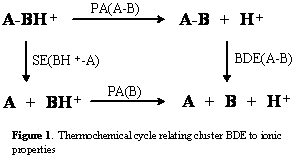AmericanChemicalSociety.com
Reports: AC6 48149-AC6: Mass Spectrometric Studies of Hydrophobic Interactions in Binary Clusters
Paul G. Wenthold, Purdue University
In the initial report on this project, we described our initial measurements of the benzene-water binding energy in the gaseous, binary cluster. The binding energy was measured by using thermochemical measurements and ion chemistry. A thermochemical cycle that illustrates our approach is shown in Figure 1. The binding enthalpy of the neutral cluster (BDE(A-B)) is related to the proton affinities of the cluster (PA(A-B)) and the monomer (PA(A)) and the solvation energy of the ion by A (SE(BH+-A)) according to equation 1. Simple proton affinities are generally well-known, and
BDE(A-B) = PA(B) + SE(BH+-A) – PA(A-B) (1)
solvation energies are often known
or can be measured. The most challenging step is generally the determination
of the dimer proton affinities, which can be obtained by mass  spectrometric
methods.
spectrometric
methods.
With that basis, we determined the binding energy in the benzene-water binary cluster. As described in last year's report, the binding energy we obtained using our measured proton affinity of the cluster along with literature values for the proton affinity of benzene and the hydration energy of protonated benzene was in good agreement with previously reported measured and computed values, leading us to expand our studies to substituted benzenes, as originally proposed for the project. Surprisingly, none of our preliminary investigations of other aromatic systems gave realistic results, with binding energies that were off by 400% or more. In an attempt to discern why benzene-water worked successfully, we took a more in-depth examination at the details of our measurement to try to identify the difference. In particular, one of the thermochemical values used in our measurement (eq 1) is the hydration energy of protonated benzene, which is the binding energy between protonated benzene and water (eq 2).
C6H7+-H2O à C6H7+ + H2O (2)
In our original measurement, we used the literature value for the solvation energy of 0.73 eV, recommended by NIST. Surprisingly, upon further investigation, we found that the hydration energy of protonated benzene, has not been measured experimentally. The current value of 0.73 eV recommended by NIST is an estimate based on an empirical correlation between proton affinity and hydration energy. Although correlations of this nature are useful for estimating hydration energies of ionic compounds when measurement is not possible, in the case of protonated benzene, the hydration energy can be easily measured by using mass spectrometry. Therefore, we embarked on a study to measure the hydration energy of protonated benzene and other aromatic ions including protonated acetophenone, anisole, phenol and toluene. In addition, we have remeasured the hydration energies for protonated aniline and benzonitrile to compare with previously measured values. We found that the measured hydration energy of protonated benzene is significantly (0.3 eV) lower than estimated value, but in good agreement with calculated values, although it is critical to use the proper geometries of the ions and sufficient basis set. In fact, the ion structure of the simplest aromatic ion cluster, protonated benzene-water, was the most challenging to determine.
Measured hydration energies of aromatic ions are listed in Table 1.
Table 1. Experimental and Calculated Hydration Energies of Aromatic Ions (values in eV)
| experimental | calculated | |
R |
| (CCSD(T)/6-31+G(d)) |
|
|
|
|
|
Aniline literature value | 0.62 ± 0.04 0.66 |
|
|
Acetophenone | 0.67 ± 0.04 | 0.71 |
|
Anisole | 0.86 ± 0.04 | 0.90 |
|
Benzene | 0.46 ± 0.06 | 0.33 |
|
literature value | 0.73 |
|
|
Benzonitrile literature value | 0.84 ± 0.04 0.82 | 0.79 |
|
Phenol | 0.75 ± 0.07 | 0.74 |
|
Toluene | 0.42 ± 0.04 | 0.29 |
|
|
|
|
|
Table 1 shows that there is excellent agreement between experimental and calculated hydration energies for most of the aromatic ions examined. The largest discrepancies, however, are found for the hydrocarbon ions, protonated benzene and toluene, where the calculated binding energy is more than 0.1 eV lower than our measured value. Then again, the agreement with the newly measured value is much better than with the literature value, where the discrepancy is 0.4 eV.
Whereas the discrepancies between the calculated and measured hydration energies of proton and toluene are not large, they are larger than what is found for other ions. This difference is attributed to using an insufficient basis set, such that the calculation was carried out by using the wrong geometry of the cluster. With the smaller basis set used for the calculations shown in Table 1, the preferred geometry of the ion looks like that in structure A, with water complexed to a localized proton on protonated benzene. However, the structure preferred with a larger basis set (6-311++G(3df,2p)) is like B, consisting of a benzene complexed to hydronium ion. When using the large basis set and proper ion geometry, the computed hydration energy of protonated benzene is 0.43 eV, in excellent agreement with the measured value of 0.46 eV, and both are significantly lower than the literature value of 0.73 eV.
The consequences of the hydration energy revision are significant. The water-benzene binding energy calculated by using the revised ion hydration energy is not in agreement with previously reported experimental or computed values. Consequently, it appears that mass spectrometric measurements of cluster proton affinities cannot be used to measure the binding in simple binary clusters.
Copyright © American Chemical Society


